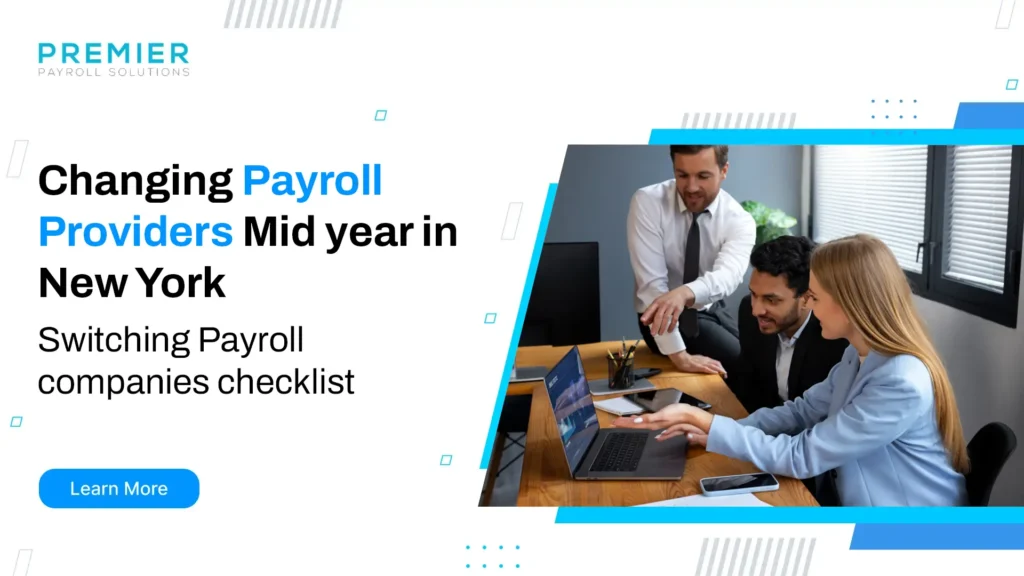Blog.
The Future of Technology:
Trends to Watch
How Much Is Paid Family Leave in New York? Updated Rates and Rules for 2025

How Much Is Paid Family Leave in New York? Updated Rates and Rules for 2025
See 2025 New York Paid Family Leave (PFL) rates, benefits, eligibility, and how much paid family leave workers can claim this year.
Changing Payroll Providers Midyear in New York: How to Switch Without Disrupting Paychecks
Understand New York City law and NY State transparency, pay range posting rules, coverage, penalties,
Prevailing Wage Certified Payroll Form in New York: 2025 Filing Requirements Explained
Understand New York City law and NY State transparency, pay range posting rules, coverage, penalties,
Full-Service Payroll Companies in New York: Stress-Free Payroll From Check to Compliance
Understand New York City law and NY State transparency, pay range posting rules, coverage, penalties,
Payroll Companies in New York: The Best Services for Stress-Free Compliance and Accuracy
Understand New York City law and NY State transparency, pay range posting rules, coverage, penalties,
Table of Contents
- 2025 New York Paid Family Leave rates at a glance
- Our services at Premier Payroll NY that help with leave setup and compliance
- Employee contribution rates in 2025 and paycheck deductions
- Who qualifies for New York Paid Family Leave
- What you can use Paid Family Leave for
- How long you can take Paid Family Leave in 2025
- How to apply for Paid Family Leave in New York
- How taxes work on New York Paid Family Leave
- Coordinating PFL with disability and employer leave
- For employers: Set up 2025 Paid Family Leave in payroll
- Special cases New Yorkers ask about
- New for 2025: Updates New York workers should know
- Our services at Premier Payroll NY to operationalize PFL in payroll
- In summary, New York Paid Family Leave in 2025
- FAQs
2025 New York Paid Family Leave rates at a glance
For official benefit math and caps, see New York’s 2025 update page at the Paid Family Leave site: 2025 updates.
How the weekly benefit is calculated
Your average weekly wage equals your gross pay from the eight weeks before leave divided by eight. Multiply that figure by 0.67 to find your weekly benefit. If that number is higher than the annual cap of 67 percent of the statewide average weekly wage, you receive the maximum of USD 1,177.32. If your schedule varies, use pay stubs from the last eight weeks to average out bonuses or overtime. If you work multiple jobs in New York, the carrier calculates the benefit based on wages from the covered employer where you take leave.
The statewide average weekly wage cap
New York resets the statewide average weekly wage each year. The 2025 figure fixes the PFL cap at USD 1,177.32 per week. You cannot receive more than that amount, even if your own average weekly wage would produce a higher 67 percent number. The cap keeps the program stable and keeps employee contributions predictable. If your pay rises midyear, your benefit for an existing continuous claim does not change, since carriers lock the rate based on the first day of that period of leave. If you start a new claim after a three‑month gap between intermittent days, the then‑current cap applies.
Examples at common pay levels
Concrete numbers make the benefit easy to understand across earnings bands. These examples assume a single employer and a standard eight‑week look‑back period.
Our services at Premier Payroll NY that help with leave setup and compliance
At Premier Payroll NY, we help you configure New York Paid Family Leave correctly from day one and keep clean records for audits. Our payroll service providers team applies the 2025 rate and stop-at-cap logic across pay frequencies. Use our HR and onboarding solution to capture notices, waivers, and acknowledgments in one place. Our integrated payroll system syncs time, PTO accurals, and employee self-service so deductions and benefit duration stay accurate. For hospitality teams, our restaurant and hospitality payroll setup handles tipped wages, shifts, and PFL deductions without manual work.
Employee contribution rates in 2025 and paycheck deductions
For step-by-step mapping by pay frequency, see Payroll Integration Guide for Small Business.
What percentage comes out of each check
Apply the 0.388 percent rate to your gross wages in each pay period. A worker paid USD 800 weekly sees a USD 3.10 deduction until they hit the annual maximum. Someone paid USD 1,500 weekly sees a USD 5.82 deduction. If payroll runs biweekly or semi‑monthly, payroll systems apply the same percentage to the period’s gross pay. If your employer deducts more than the cap by mistake, report it to HR for a prompt correction.
Annual cap on contributions
Once your year‑to‑date PFL deductions reach USD 354.53 in 2025, payroll should stop taking more for the rest of the calendar year. That cap applies to each employer separately, not across all employers. If you work two covered jobs, each employer withholds up to the cap. As a result, you could pay more than USD 354.53 in total if you hold multiple jobs. You can ask each payroll to review expected earnings and adjust timing so you do not hit both caps too early.
Who is exempt or reimbursed
Some workers can file a waiver and skip deductions if they will not work long enough to qualify. If your schedule later changes so you will meet eligibility, the waiver revokes and payroll can collect retroactive contributions back to your hire date. If payroll takes deductions in error and you never become eligible, ask for a refund based on your employer’s carrier rules. Keep copies of your waiver and any notices for your records.
Seasonal and temporary workers
If you work 20 or more hours a week but will not reach 26 consecutive weeks, or you work fewer than 20 hours a week and will not reach 175 days in a year, you can sign a PFL waiver. With an approved waiver, the employer should not deduct contributions and you will not have PFL coverage. If your schedule later extends, the waiver ends and payroll can start deductions and collect back the missed amounts.
Public sector employees
Public employers do not have to provide PFL unless they opt in. Many public employers have added PFL through collective bargaining or policy. If you work in the public sector, ask HR whether your agency offers PFL and how deductions work. Union contracts may include unique rules on contributions, waiting periods, and coordination with other paid leaves.
Union plans and waivers
Unionized workplaces may bargain PFL terms, including whether the employer pays the premium instead of employees. If your union negotiated an opt‑in to PFL, you will follow the contract language for deductions and benefits. If your union did not opt in, you may not have PFL even if a similar non‑union role has it. Review your CBA and any PFL rider or side letter carefully, especially if you plan a bonding leave.
Who qualifies for New York Paid Family Leave
Eligibility hinges on where you work and how long you have worked for the employer. Private employers with at least one employee in New York must provide PFL. You qualify as a full‑time employee after 26 consecutive weeks with the same employer. You qualify as a part‑time employee after working 175 days for the same employer. Your residence and immigration status do not affect eligibility as long as your employment is considered New York employment.
Eligibility for full-time and part-time employees
Full‑time employees qualify after 26 weeks with a regular schedule of 20 hours or more. Part‑time employees with schedules under 20 hours qualify after 175 workdays, regardless of hours per day. Paid and unpaid days count toward the 175‑day threshold if you worked at least part of the day. If you change jobs, the clock resets, and you must build eligibility with the new employer. If you sign a waiver because you do not expect to reach eligibility, the waiver revokes if your schedule changes to meet the threshold.
Covered family relationships under the law
You can use PFL to care for or assist certain family members. Covered relationships include a spouse, domestic partner, child, stepchild, parent, stepparent, parent‑in‑law, grandparent, and grandchild. Siblings also count. You cannot take PFL to care for your own serious health condition, which falls under disability benefits. For bonding, the law covers birth, adoption, and foster placement during the first 12 months.
Citizenship and immigration status
Citizenship never factors into New York PFL eligibility. If you meet the work and service rules for a covered employer, you qualify for job protection, wage replacement, and continued health insurance. You still must submit complete forms and proof just like any other worker. If you fear retaliation based on status, you can file a complaint and seek reinstatement with back pay under state protections.
What you can use Paid Family Leave for
PFL covers three high‑impact family needs so workers can care for loved ones without losing their job. You can bond with a new child, care for a family member with a serious health condition, or respond to certain military deployments. Each reason has its own form and proof requirements. Plan your request with HR and your carrier so your paperwork matches the reason.
Bonding with a new child
You can take PFL for birth, adoption, or foster placement within the first 12 months. Birthing parents often use disability benefits for medical recovery, then switch to PFL for bonding. Non‑birthing parents can use PFL for bonding from day one. You need proof such as a birth certificate, letter from a health care provider, or placement papers. If both parents work for covered employers, each one can take up to 12 weeks. Leave can be continuous or intermittent in full‑day increments.
Caring for a seriously ill family member
You can use PFL to care for a covered family member with a serious health condition. Care can include help during isolation after treatment and certain dental surgeries when a provider certifies a serious health condition. A health care provider must certify the diagnosis and the level of care needed. Care includes help with treatment, transportation, medication, meals, and daily activities. You can use intermittent days for recurring appointments or flare‑ups. Coordinate your schedule with other relatives so you do not exceed the 12‑week limit across all leave periods in a 52‑week window.
Military family needs and exigency leave
You can use PFL for certain needs when a spouse, domestic partner, child, or parent is deployed abroad on active military duty. Covered activities include attending military ceremonies, making legal or financial arrangements, or arranging child care. Keep copies of deployment orders and event schedules for your claim. If the service member’s status changes, notify your carrier to adjust your leave dates.
Prenatal appointment leave and where PFL fits
Starting in 2025, New York requires employers to provide 20 hours of paid prenatal leave for pregnancy‑related medical care under the state sick leave law. This paid prenatal leave sits outside PFL. Expectant parents still use PFL to bond with a new child after birth or placement. If you need time mid‑pregnancy to care for a spouse with complications, PFL family care may apply if a provider certifies a serious health condition. For details, see the NY Department of Labor employee fact sheet on paid prenatal leave PDF.
How long you can take Paid Family Leave in 2025
PFL grants up to 12 weeks each 52‑week period for eligible reasons. You can split that time into separate blocks as long as you take full days. If more than three months pass between intermittent days, a new claim starts. When PFL overlaps with FMLA for the same reason and you work for a covered employer, the two can run at the same time if your employer designates it correctly. You cannot take more than 26 weeks combined of PFL and New York disability benefits in any 52‑week period.
Maximum weeks available this year
Every eligible worker can claim up to 12 weeks of PFL in 2025. That limit resets on a rolling basis one year after the first day of your leave. If you used 12 weeks last spring, you regain eligibility one year from that start date, not on January 1. If you change employers midyear, your new eligibility depends on your weeks or days worked for the new employer.
Intermittent leave rules and partial days
PFL allows intermittent leave only in full‑day increments. You cannot claim half days under PFL even if FMLA allows partial days for the same condition. Carriers count the maximum number of days you can take based on the average days you work per week. For example, if you work three days per week, you can take up to 36 PFL days in a benefit year. Track your remaining days so your requests match your schedule.
How PFL interacts with FMLA
If your employer is covered by FMLA, the company can require PFL and FMLA to run together for the same reason. To do that, HR must notify you in writing that the leave qualifies under both laws and will run concurrently. When leaves run together, you protect your job and health coverage under both laws while receiving the PFL wage benefit from the carrier. If the reasons differ, such as your own medical condition under disability and later bonding under PFL, the leaves do not overlap.
How to apply for Paid Family Leave in New York
For building clear, searchable claim files, our guide on organizing complex evidence can help: Payroll Integration Guide for Small Business.
Notify your employer and the insurance carrier
Tell your employer at least 30 days in advance when you know the dates for bonding or planned procedures. If you cannot, notify your employer as soon as possible. Your employer completes its section of the request form within three business days and returns it to you. You submit your full package to the insurance carrier listed on your employer’s notice of compliance. Carriers must pay or deny a completed claim within 18 days of receipt or the first day of leave, whichever is later. You can also start at the state pfml resource center website to find the carrier name and contact.
Complete the right PFL forms for your reason
Every claim starts with the Request for Paid Family Leave, Form PFL‑1. For bonding, add Form PFL‑2. For caring for a family member, include Forms PFL‑3 and PFL‑4, which cover the release and the provider certification. For military family leave, include Form PFL‑5. Your employer and the health care provider fill out their sections and return them to you. Submit legible copies and keep the originals for your records.
Deadlines, documentation, and proof to include
Send your claim within 30 days after your first day of leave. Late filings can reduce or deny benefits. Attach proof that matches your reason. For bonding, include a birth certificate, a hospital letter, or placement documents. For family care, include the provider certification and any treatment plan. For military leave, include copies of orders and event notices. Double‑check your dates and signatures to avoid avoidable delays.
Medical certification tips that speed approvals
Ask the provider to write clear diagnoses and expected care needs. If appointments recur, ask the provider to specify frequency and duration. For intermittent care, ask for a schedule range that covers likely visit patterns. Make sure names and dates match across every document. If the provider believes disclosure could harm the patient, the provider can decline to complete a certification and you should contact the carrier for next steps.
How taxes work on New York Paid Family Leave
If you evaluate outsourcing to improve compliance and workload, read Payroll Outsourcing Explained.
Is PFL taxable income for federal and state
The IRS treats PFL benefits as taxable income. You should include the 1099 you receive from the carrier when you file your return. New York tax rules can vary by situation, so confirm with a tax professional. You can request voluntary federal withholding with some carriers if you want to avoid a surprise tax bill in April.
W‑2 reporting details including Box 14
Your PFL payroll contributions appear on your Form W‑2 in Box 14 with a description such as NYPFL. These contributions are not pre‑tax. They do not reduce federal taxable wages. Keep your last pay stub of the year and the W‑2 in case you need to confirm your year‑to‑date deduction amount.
Impact on other benefits and credits
PFL benefits can affect income‑based programs and credits because they increase your total income for the year. Review how a 12‑week benefit might shift your earned income credit, child tax credit, or marketplace health subsidy. If you receive public benefits, ask the administering agency how temporary wage replacement counts. If your employer offers a 401(k) match only on active pay, the match may pause during unpaid time away.
Coordinating PFL with disability and employer leave
Understand how PFL lines up with disability benefits and company policies so you do not leave money on the table. You cannot take PFL and New York short‑term disability at the same time. If both apply in the same 52‑week period for different reasons, you cannot exceed 26 weeks combined. Company paid parental leave can run with PFL if the employer designates it. PTO can top up PFL but does not change the PFL calculation.
PFL versus New York short-term disability (DBL)
Disability benefits cover your own off‑the‑job injury or illness. Birth recovery falls here for birthing parents. PFL covers bonding and family care, not your own condition. Many birthing parents use DBL for the medical recovery period, then shift to PFL for bonding. Keep separate claim files and submit the correct forms to each carrier if different insurers administer them. Keep NY disability and PFL claim numbers separate and line up dates so benefits do not overlap.
Using PTO or sick time with PFL
Some employers allow or require you to use accrued PTO or sick time at the same time as PFL to bring income closer to full pay. PTO does not reduce your PFL weekly benefit, and it does not extend the 12‑week maximum. Ask HR whether PTO runs concurrently and how to record it in the timekeeping system. Keep a copy of your PTO policy with your claim file. Add a simple tracker so employees can see PTO accurals that run with PFL without changing the carrier benefit.
Company policies and collective bargaining agreements
Employer handbooks and union contracts can set notice deadlines, documentation rules, or supplemental pay plans that go beyond the statute. If you work under a CBA, check whether it synchronizes FMLA and PFL automatically. If your company pays full salary during leave and seeks reimbursement from the carrier, confirm how and when the company will reconcile amounts.
For employers: Set up 2025 Paid Family Leave in payroll
For vendor selection and configuration checklists, see Best Payroll for Small Business: 2025 Guide and Payroll Outsourcing Explained.
Configuring deductions and rate changes correctly
Update your payroll system with the new rate and cap and test with sample paychecks across different pay frequencies. Set triggers to stop deductions once year‑to‑date totals reach USD 354.53. For multi‑state employers, use location‑based payroll profiles so New York workers receive deductions while out‑of‑state workers do not. If you discover over‑withholding, process a timely refund and adjust your next payroll.
Employee notices, posters, and handbook updates
Post the current notice of compliance where employees can see it and include the insurance carrier name and policy number. Update your handbook to state the 2025 benefit cap, the contribution rate, the 12‑week limit, and how to file a request. Add model language to onboarding packets so new hires know about deductions from the first check. Keep a clear escalation path for questions about waivers and multi‑employer situations.
Recordkeeping, audits, and carrier communications
For structuring labels, IDs, and event markers across systems, we outline field setups here: Best Payroll for Small Business: 2025 Guide.
Audit-proof checklist for 2025
Run a quarterly self-audit with three files ready at all times: deduction reports, waiver forms, and carrier invoices. Test the stop-at-cap logic with low, mid, and high earners before the first February payroll. Keep a one-page flow for escalations so HR, payroll, and the carrier resolve mismatched wage statements in days, not weeks. Document how intermittent days convert to weeks for employees with nonstandard schedules so you can defend calculations in a review. Save denial letters and approval letters by employee for at least four years to show complete claim histories.
Vendor support checklist for smooth setup
If you partner with a payroll or HRIS vendor, confirm they have the 2025 rate and cap configured, location profiles for New York employees, and stop-at-cap logic tested. Ask for mapped PFL pay codes, PTO top-up rules, and an alert when a worker nears the annual maximum. Ensure model notices are available in onboarding packets and that carrier contacts appear in the employee portal. Request a year-end W-2 Box 14 validation report. For seasonal and student workforces, confirm that waiver prompts and secure storage for signed waivers exist.
Special cases New Yorkers ask about
Real life brings edge cases, and New York’s guidance covers most of them. Workers with multiple jobs can file with one employer or both at the same time. Independent contractors are not automatically covered but can opt in as self‑employed. Public employees may have PFL if their agency opted in. Remote employees outside New York are not in New York employment even if their employer is based in New York.
Multiple jobs and filing separate PFL claims
If you work for two covered New York employers, you may take leave from one job or both. If you take leave from both, you must take the leave during the same time period, not consecutively. Each carrier calculates benefits based on wages from the corresponding employer. Your total PFL time across all jobs still cannot exceed 12 weeks in a 52‑week period. Keep both HR teams informed so schedules do not conflict.
Gig workers, contractors, and eligibility limits
For sector-specific tips, see Best Hospitality Payroll Software in NY.
Job protection and continued health insurance
PFL protects your job and keeps your group health insurance in place while you pay your normal share. If you do not pay your share, the employer can stop coverage after required notices. When you return, the employer must reinstate you to the same or a comparable role with the same pay and benefits. If your employer cuts your pay or hours because you used PFL, you can file a discrimination or retaliation complaint. If your return rights seem at risk, seek prompt advice from employment counsel.
Out-of-state remote workers on New York payroll
PFL looks at where you perform work, not where the company sits. If you live and work outside New York, you likely are not in New York employment even if the company is located in the state. Telecommuting from another state for a New York employer usually does not qualify. If your role is localized in New York and you only travel occasionally, you may still qualify. Confirm your status with HR if you moved during the year.
New for 2025: Updates New York workers should know
Each year brings fresh numbers and occasional policy changes. For 2025, the statewide average weekly wage increased, which raised the PFL weekly cap to USD 1,177.32. The employee contribution rate sits at 0.388 percent with an annual maximum of USD 354.53. New York also added 20 hours of paid prenatal leave as part of paid sick leave, separate from PFL. Employers should update their posters, model language, and payroll settings to match.
Updated benefit cap and statewide wage figure
The statewide average weekly wage for 2025 sets the PFL cap at USD 1,177.32 per week. That change boosts maximum total benefits for a full 12‑week claim to USD 14,127.84. Workers whose 67 percent calculation falls below the cap see no change from the cap itself, but they may still see a higher benefit if their own pay rose. Carriers determine the benefit based on the average weekly wage as of the first day of your claim period.
Contribution rate change and annual maximum
The 2025 contribution rate equals 0.388 percent of wages with a yearly cap of USD 354.53. Payroll must apply the rate to each pay period and stop deductions after you hit the cap. If you work multiple jobs, each employer tracks the cap separately. Employers can choose to pay the premium and skip employee deductions, and some union contracts take that route.
Pregnancy-related paid leave law and PFL coordination
Starting in 2025, pregnant workers in New York receive 20 hours of paid prenatal leave for medical appointments under state law. This leave sits apart from PFL and does not reduce your 12‑week PFL bank. Use prenatal leave for visits during pregnancy, disability benefits for birth recovery if applicable, and PFL for bonding after birth or placement. Update your leave plan with HR so each type of leave lands in the correct bucket.
Our services at Premier Payroll NY to operationalize PFL in payroll
At Premier Payroll NY, we help you turn policy into practice with tested payroll configurations and clear employee tools. Lean on our New York payroll experts to set deduction profiles, intermittent leave mappings, and multi-job scenarios. The integrated payroll system connects HR, time, and benefits so carriers get accurate wage statements the first time. Our HR and onboarding solution delivers updated handbooks, posters, and employee notices. For leadership teams evaluating vendors, see our overview of professional payroll service providers.
In summary, New York Paid Family Leave in 2025
A quick recap helps you plan time and pay with fewer surprises. The bullets below compress the rules into practical notes, then we close with a next step you can take today.
- Benefit rate equals 67 percent of your average weekly wage, capped at USD 1,177.32 per week in 2025.
- The cap tracks the statewide average weekly wage and resets each year.
- A new claim after a three‑month gap uses the then‑current cap.
- The cap tracks the statewide average weekly wage and resets each year.
- Eligible workers get up to 12 weeks in a rolling 52‑week period.
- Intermittent leave must use full‑day increments, not partial days.
- Combined PFL and disability in a year cannot exceed 26 weeks.
- Intermittent leave must use full‑day increments, not partial days.
- The 2025 payroll contribution rate equals 0.388 percent with a USD 354.53 annual cap.
- Each employer tracks the cap separately for multi‑job workers.
- Waivers apply to short‑term or very part‑time schedules and can trigger retro deductions if schedules change.
- Each employer tracks the cap separately for multi‑job workers.
- Covered reasons include bonding, family care, and certain military needs.
- Prenatal leave adds 20 paid hours separate from PFL.
- Your citizenship does not affect eligibility.
- Prenatal leave adds 20 paid hours separate from PFL.
- Taxes apply to PFL benefits at the federal level.
- Carriers usually issue a 1099, and your W‑2 shows Box 14 contributions.
- Consider voluntary withholding or quarterly estimates.
- Carriers usually issue a 1099, and your W‑2 shows Box 14 contributions.
You can lock down your dates, pull pay stubs for the eight‑week average, and start the forms now. A tidy file, early notice, and correct proofs speed approvals and keep income flowing when your family needs it most.
FAQs
How much will I get each week in 2025
You receive 67 percent of your average weekly wage up to USD 1,177.32 per week. If 67 percent of your wage falls under the cap, you get that exact amount. If it exceeds the cap, you get the capped maximum. Carriers set the rate based on the first day of your leave period. If you start a new claim after a three‑month gap between intermittent days, the new rate applies.
What is the New York Paid Family Leave contribution rate
The 2025 rate equals 0.388 percent of gross wages with a maximum annual deduction of USD 354.53. Payroll withholds every pay period until you reach the cap. If you hold two jobs, each employer applies the cap to your wages with that employer. Employers can choose to pay the premium and not withhold from employees.
How many weeks can I take under PFL
You can take up to 12 weeks in a rolling 52‑week period. Take the time all at once or intermittently in full‑day increments. If more than three months pass between intermittent days, a new claim begins. You cannot exceed 26 weeks combined of PFL and New York disability benefits in any 52‑week period.
Do part-time employees qualify for PFL benefits
Yes. Part‑time workers qualify after 175 workdays with the same employer. Those days include any day you worked, regardless of hours that day. If you work less than 20 hours weekly and do not expect to reach 175 days in a year, you can file a waiver to skip deductions. If your schedule later expands, the waiver ends and payroll can take retroactive deductions.
Can I receive PFL and short-term disability at the same time
No. You cannot receive PFL and New York short‑term disability at the same time. You can take them in the same year for different reasons, but combined time cannot exceed 26 weeks. Birth recovery often uses disability first, followed by PFL for bonding. Keep separate claims and proofs for each benefit.




